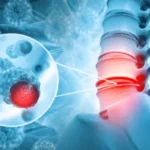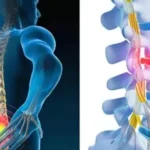Understanding What Is Sciatica: More Than Just Back Pain
That sharp, stabbing pain running from your lower back into your buttock and down your leg could be more than typical back pain. You might be facing sciatica if this type of discomfort sounds familiar. Sciatica happens when the sciatic nerve, which is the body’s longest nerve, gets pinched or irritated. Knowing what sciatica is helps take the first step to treat the issue and find relief. For proper diagnosis and care, consult the best doctor for back pain in Delhi.
The sciatic nerve stretches from the lower part of your spine, through your hips and buttocks, and runs down both legs. When something compresses or irritates this nerve, it can trigger pain that follows its path. Many say this pain feels like a sharp, shooting sensation that is hard to ignore. Spotting symptoms of sciatica early can prevent it from getting worse and help you recover quicker.
Recognizing Sciatica Symptoms: Early Warning Signs
Sciatica comes with clear signs that make it different from regular back pain. Knowing these early clues can really help you in your treatment process.
Here are the most frequent sciatica symptoms:
- Sharp pain that feels like burning spreads from the lower back through the buttock and down one leg
- Electric shock sensations run down the leg
- Numbness, tingling, or weakness shows up in the affected foot or leg
- Pain gets worse when sitting, standing too long, or sneezing and coughing
- Pain or weakness makes moving the leg or foot hard
Sciatica can be tough to deal with because symptoms vary a lot. Some people feel mild discomfort, while others experience intense pain that makes simple tasks hard. Leg pain from sciatica may feel mild at times but can also be so severe it interferes with daily life.
What Causes Sciatica: Understanding the Root of the Problem

Understanding the causes of sciatica helps people prevent it from coming back. Different issues can press on or bother the sciatic nerve, which results in sciatica:
- Herniated or Slipped Disc: The soft inside of a spinal disc can push out through the harder outer layer and press on the sciatic nerve.
- Spinal Stenosis: A narrow spinal canal may squeeze the nerve roots.
- Spondylolisthesis: One vertebra moving forward on top of another can press against nerve roots.
- Piriformis Syndrome: Tightening or spasms in the piriformis muscle can irritate the sciatic nerve.
- Trauma or Injury: A direct hit or injury to the sciatic nerve or nearby tissues might cause issues.
Certain factors raise the likelihood of getting sciatica, like age (between 30 to 50 years) being overweight sitting for long periods, and jobs that involve heavy lifting or twisting your back.
Effective Sciatica Treatment: Modern Approaches
If you have ongoing sciatica pain that spreads down your leg seeing a doctor is important. In Delhi advanced treatments for sciatica are offered at clinics specializing in spine care. These centers provide different solutions depending on how serious your condition is.
Common treatments often include:
- Conservative Treatments:
- Adjust activities and take rest.
- Try physical therapy with targeted exercises.
- Use basic painkillers from the pharmacy.
- Apply heat or ice packs to manage pain.
- Medical Treatments:
- Doctors may give strong pain pills or muscle relaxers.
- Steroid injections might ease pain near the spine.
- You could do specialized physical therapy programs.
- Surgery Choices (when it is very bad):
- Microdiscectomy.
- Laminectomy.
- Spinal fusion.
Doing sciatica exercises helps strengthen your back and ease discomfort. A trained physical therapist can create a custom plan for you. The focus will be on building strong core muscles making you more flexible, and helping you maintain good posture.
Finding the Right Doctor for Back Pain
If you are struggling with ongoing sciatica, you need to see the best spine doctor in Delhi to get the right diagnosis and care. Finding the right doctor can improve how well you recover.
Sant Paramanand Hospital in Delhi has the Delhi Institute of Trauma and Orthopedics, or D.I.T.O., which provides full spine care services. Dr. Amit Shridhar leads the Spine Surgery Unit. He focuses on invasive spine procedures and has a lot of experience helping people manage sciatica and other spine problems.
To choose the best spine specialist, patients should focus on doctors who are skilled in treating sciatica. Key considerations include experience, treatment approach, and patient reviews. To ensure proper care, always start by trying to find the best spine doctor for your specific condition.
- Focus on spine problems
- Time spent working in the field
- Feedback from patients and their stories
- Connection to hospitals and resources offered
- Way of treating patients (non-surgical or surgical)
Comparing Treatment Options: Making an Informed Decision
| Treatment Approach | Benefits | Recovery Time | Best For |
| Physical Therapy | Non-invasive, strengthens supporting muscles | 4-8 weeks | Mild to moderate cases |
| Medication | Quick pain relief, reduces inflammation | Varies | Acute pain management |
| Epidural Injections | Targeted relief, reduces inflammation | 2-7 days for effect | Moderate to severe pain |
| Minimally Invasive Surgery | Less tissue damage, faster recovery | 2-4 weeks | Severe cases unresponsive to conservative treatment |
| Traditional Surgery | Addresses complex issues | 4-6 weeks or more | Severe structural problems |
Patient Experience: A Case Study of Sciatica Recovery
Om pal, a 42-year-old IT worker living in Gurgaon, dealt with lower back pain that kept getting worse over several months. At first, he thought it was just stress from his job, but his worry grew when the pain turned into sharp shooting sensations traveling down his right leg. Even basic things like putting on shoes became unbearable.
“The pain was nothing like I’d felt before,” Om pal says. It felt like an electric shock down my leg after sitting too long at work.
Om pal turned to Sant Paramanand Hospital after looking up specialists. The doctors there ran a detailed checkup and an MRI. They found out he had sciatica from a herniated disc. His recovery plan combined focused physical therapy, anti-inflammatory drugs, and changes in daily habits.
“What stood out to me was how thorough the care was,” Om pal explained. “The doctor didn’t just treat my pain. They made sure I understood what was going on and why. The therapy exercises looked easy but worked wonders over time.”
Om pal stuck to the treatment for eight weeks and felt much better afterward. He keeps himself healthy now by staying active and adjusting his workspace.
“I wish I had sought help sooner,” he says. “Knowing what was wrong and having a clear direction to get better felt just as important as the treatment itself.”
When to Seek Immediate Medical Attention
Though sciatica often gets better with the right care and time, some signs mean you need to act fast:
- Intense pain in your lower back or leg that hits
- Weakness or numbness in your legs
- Trouble controlling your bladder or bowel
- Numbness in the area around your genitals or buttocks
These could point to cauda equina syndrome. It is uncommon but serious and needs emergency care to stop permanent nerve damage.
Frequently Asked Questions About Sciatica
Q: Can sciatica heal without treatment?
A: Sometimes mild sciatica improves by itself in a few weeks. Persistent or severe cases need a doctor’s care to avoid lasting nerve issues.
Q: How long does sciatica last?
A: It depends on what caused it and how bad it is. Short-term sciatica lasts one to two weeks. If it becomes chronic, it can stick around for months unless treated.
Q: Is walking helpful for sciatica?
A: Gentle walking helps sciatica by improving blood flow and boosting natural pain relievers. It’s important to take it slow and not do anything that makes the pain worse.
Q: Can sciatica cause pain in both legs at the same time?
A: Sciatica happens on one side, but it can also show up in both legs. This might occur if someone has central spinal stenosis or more than one herniated disc.
Q: Do any home remedies help sciatica pain?
A: Some simple ways to ease sciatica pain at home include using hot and cold packs, doing light stretches, and taking anti-inflammatory medicine that you can buy without a prescription. These methods can help for a while before getting professional care.
Conclusion: Taking Control of Your Sciatica Journey
Sciatica doesn’t mean you’re stuck with pain forever. By catching symptoms and getting the right treatment most people can feel a lot better and get back to their everyday routines.
If you think you might have sciatica, do not wait for the pain to get worse. Sant Paramanand Hospital in Delhi offers comprehensive sciatica treatment in Delhi, with thorough evaluations and personalized care plans tailored to your condition. Acting early helps you recover faster and achieve better outcomes.
When you learn about your condition and team up with skilled doctors, you can manage sciatica and aim to live without pain.



